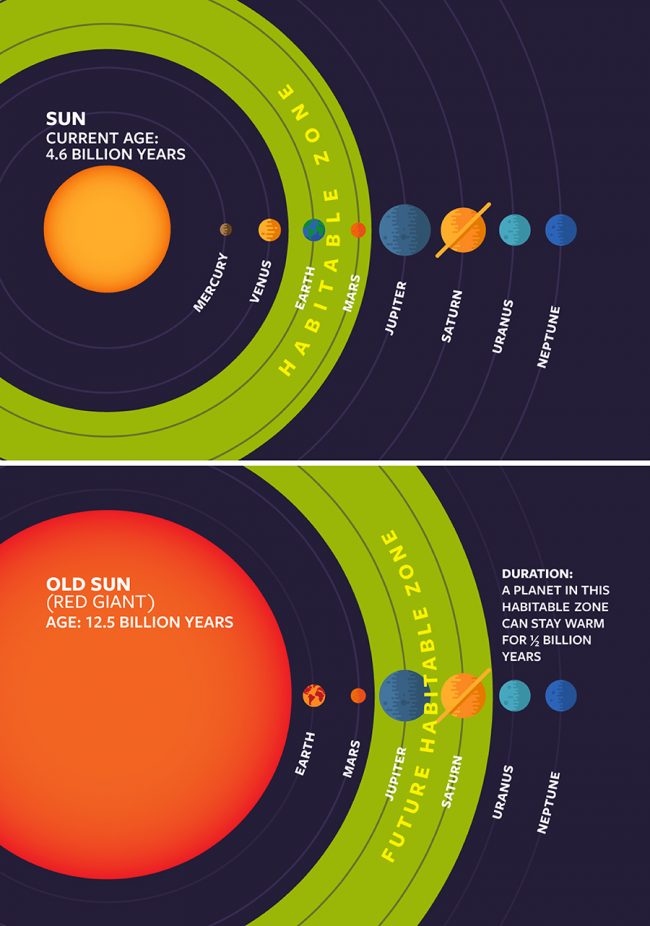
Earth exists thanks to our sun, having formed in orbit around it from a huge cloud of gas and dust in space, 4.5 billion years ago. Likewise, the sun will ruin Earth for living things, some 5 billion years from now. As the sun evolves, it’ll expand to become a red giant star and fry our planet to a cinder. What’s more, the death of the Earth will happen against a backdrop of change on a galactic scale. Our Milky Way galaxy and the Andromeda galaxy will be in the midst of a colossal collision that’ll forever alter our galactic home in space.
Our sun is a G-type star currently about halfway through its life cycle. This type of star is very stable for the majority of its life, quietly fusing hydrogen into helium in its interior for billions of years. One day, the hydrogen in the sun’s interior will be depleted. At that point, the inward pressure of gravity will win out over the outward pressure of the sun’s internal fusion, until the sun heats up enough to start fusing helium. At that point, the sun will balloon outward to become a red giant star.
EarthSky lunar calendars are back in stock! We’re guaranteed to sell out. Get one while you can!
As the sun heats up and expands, its outer layers will envelop the innermost planets, Mercury and Venus. The outer edge of the sun will grow to reach roughly the orbit of Earth. Our planet’s water and atmosphere will boil away, leaving nothing behind but a charred, lifeless rock. Mars will take a while to heat up, but, eventually, Mars will be outside the habitable zone for humans, too. At that point, the moons of the outer planets – like Jupiter and Saturn – will be the only places left in our solar system for human colonies.
But these locations, too, will be only temporary fixes in the search for a new home.

The red giant phase of the sun might continue for a billion years or so, but eventually the helium will run out, too. Then the sun will blow off an envelope of gas. Astronomers peering through telescopes in other star systems will see our sun as what we call a planetary nebula, a great shell of gas surrounding a dying star. Ultimately that shell will dissipate off into space, and what’s left of our sun will become a white dwarf star.
Earth’s astronomers can look outward into space to glimpse of Earth’s future. For example, 400 light-years away, a star known to astronomers as SDSS J1228+1040 is a white dwarf with its gas nebula funeral shroud, and within it astronomers have found the signature of a planetesimal still orbiting its home sun long after its calamitous death.
And what of the Milky Way galaxy itself, the great island of stars containing our Earth and sun? By the time our sun is ballooning into the red giant phase – long before it settles down as a white dwarf – the Milky Way itself will be undergoing a long process of inevitable collision with the giant spiral galaxy next-door, the Andromeda galaxy. The last humans on Earth – if any humans are left a couple of billion years from now – will see the Andromeda galaxy growing larger and brighter in the night sky. It’s currently barely visible to the unaided eye from a dark-sky site. But, a couple of billion years from now, the Andromeda galaxy will be a breathtaking, unmistakable whirl of stars easily visible in the night sky of any and all Earthly inhabitants.
As Andromeda and the Milky Way move closer to each other, the Andromeda galaxy’s great mass will begin to affect the stars in our Milky Way. Our galaxy is wide and flat, like a pancake. We on Earth currently see its stars on a dark August evening as a great hazy band across the sky. But as the gravity of Andromeda distorts their paths, the Milky Way’s stars will be strewn across our sky.
It may seem incredible, but stars within galaxies are so far apart that even when the two giant spirals collide there will be few fireworks from collisions between stars. However, gas clouds in the two galaxies will likely collide, forming vast conglomerations of new stars.

Ultimately, the Milky Way and Andromeda galaxies will settle down to form a new massive blob-shaped galaxy. By this point, Earth, our sun and the rest of our solar system might be in some entirely new location with respect to the galactic center. At present, Earth lies some 25,000 light-years from the center of the Milky Way. After Andromeda and the Milky Way merge, astronomers believe our home in space will have been ripped outward to a new galactic orbit some 100,000 light-years from the center of the new, large Andromeda-Milky Way combo galaxy. As theorist T.J. Cox of the Harvard-Smithsonian Center for Astrophysics said:
You could say that we’re being sent to a retirement home in the country.
And what will be the fate of humanity? That’s impossible to say. If it survives, humanity’s future will depend on our ability to travel away from our dying sun and set up camp elsewhere.
Fortunately, we have a few billion years to figure out how to accomplish this monumental task.
Bottom line: What will be Earth’s fate? Earth is bound to become a dry, scorched rock, as our sun becomes a red giant star. What’s more, as the Milky Way and Andromeda galaxies collide, our sun and Earth (and the rest of our solar system) are expected to be hurled outward, away from the galactic center, to the outskirts of a new large galaxy created in the collision.











